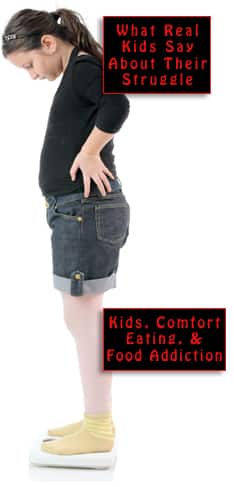 Childhood obesity is such a complicated problem that we need to come at it from every possible direction, and chip away at it from any angle that looks promising. Dr. Pretlow has been calling attention to the fact that food addiction is real, and needs to be treated like any other addiction.
Childhood obesity is such a complicated problem that we need to come at it from every possible direction, and chip away at it from any angle that looks promising. Dr. Pretlow has been calling attention to the fact that food addiction is real, and needs to be treated like any other addiction.
Many young people have communicated with the Weigh2Rock website, plainly stating that they were addicted, particularly to junk food and fast food. The effects of obesity cause real pain in their lives, and they know that eating those foods will result in further weight gain, yet they are unable to resist. They also clearly say that they are fed up with advice about healthy eating. They know that fruit is better than cheese fries, but an encyclopedia full of nutritional knowledge can’t help them resist the cravings that are messing up their lives.
But there is a segment of the population whose slate is still clean, and who can be steered away from falling prey to food addiction. With good beginnings, they can grow into kids who never need bariatric surgery, or 12-step programs designed to free them from addiction, or intervention of any kind, because addiction to highly pleasurable foods never becomes entrenched. As the old saying goes, an ounce of prevention is worth a pound of cure. If small children can be guided to start out on a healthy-eating path, that early training may be all they would ever need.
So, how do we give kids a good start? Elyse Schneiderman thinks the Donut family can help — no, not the sugary ones that come from the bakery. These Donuts are the characters in her book for kids from ages three to eight. With an advisory board consisting of several grandchildren, the author conjured up the family that includes Jelly Donut, Chocolate Donut, Glazed Donut, and even a dog named Cream, who all live in a donut -shaped house. They appear in the book Jelly and the Donuts, which is both a lot of fun and a great educational tool.
Poor Jelly, the main character, is overweight even for a donut. He is teased and bullied, picked last for games, and consequently has low self-esteem. But Jelly wants to change, and he does, through increasing his physical activity and switching his eating habits to healthy choices. With delightful creativity, and embellished with amusing illustrations by Mike Swain, Jelly and the Donuts deals with family and individual issues that are current and widespread. It includes important messages for both children and parents.
Jelly and the Donuts, released in the fall of 2010, hit the ground running with both a Facebook fan page and a rockin’ little music video titled “If You Want to Be Healthy.” The book is subtitled “Part I — Life with the Donuts,” because this is only the Donut family’s first appearance. They will return in the projected two more books of the series. A Children’s Healthy Activity workbook is also on the drawing board. Dr. Pretlow says,
Healthy, fun foods are ideal for: 1) weaning obese kids off of addicted foods, 2) subsequently avoiding those foods to which they were previously addicted, and 3) preventing healthy weight kids from becoming addicted to begin with.
In Overweight, What Kids Say, Dr. Pretlow lists several means by which young people have reported success in escaping from obesity. For one, they do their best to avoid “hookable” foods by not letting them in the house and not frequenting the places where these foods are available. Dr. Pretlow says,
They stock the house with fruits and veggies for snacks… They go shopping with their parents and buy low-fat, sugar-free foods for comfort and healthy foods like fruits for snacks. They have fun with it… smoothies anyone? The kids get out of the house… They go for a walk with the family dog or a friend. They go for a bike ride, or rollerblade, or go on a hike, or visit a museum, or the library, or volunteer at the local animal shelter by caring for lonely pets.
Tim O’Meilia’s interesting profile quotes Elyse Schneiderman as saying,
Obesity affects children’s lives, both psychologically and physiologically. Overweight kids grow up to be overweight adults.
The importance of dealing with childhood obesity is obvious. In the author’s Florida town, her book has found such allies as Community Supported Agriculture, a collective that sells organic produce. When a nonprofit group invites Schneiderman to give a talk and hold a book signing, her share of the book profits goes to the host group.
Before becoming a children’s author, Schneiderman taught at high school and college levels and sold real estate, in addition to being a columnist, marketer, and bead artisan. Most relevant to the eventual creation of Jelly and the Donuts was her career as a psychologist specializing in family therapy and eating disorders. The author responded to questions from Childhood Obesity News by providing some exclusive background on her interest in the subject, and her time as a psychotherapist:
During the years of private practice I treated adults. I also was a specialist in eating disorders. I treated many bulimic and morbidly obese women. With a nutritionist, for five years I ran two groups a week for overweight females. Most of the women I treated were not obese children. I knew nothing about childhood obesity.
Schneiderman’s son was diagnosed as morbidly obese at the age of 10, and sometimes shared what it was like to be a fat kid — the humiliating incidents, the bullying, the emotional problems. It was easy to see how difficult life is for an overweight child. She says,
Of my four children, he was the only child that did not exercise or play sports. We were a very active family but he resisted any exercise until he was older.
But exercise he did, eventually, and learned better eating habits too. The fact that her son has maintained a healthy weight for 20 years now is ample demonstration that kids can change their patterns, and childhood obesity does not have to turn into a lifelong sentence.
Nevertheless, Schneiderman was slightly shocked this Thanksgiving when her son outed himself as a sugar addict. Okay, she once found 12 coke cans under his bed, but the notion of addiction has never entered her head, which is not surprising, because among healthcare professionals, food addiction was not then recognized as a reality. And, despite the fact that this man shaped up and has maintained a healthy weight for half his life, he still has not been able to give up sugar entirely.
Jelly and the Donuts is available from Amazon.com, where reviewer Todd Rutherford calls the book enlightening, educational, and wildly entertaining.
Your responses and feedback are welcome!
Source: “Overweight: What Kids Say,”Amazon.com
Source: “The 6th career of high-energy Elyse Schneiderman,” Palm2Jupiter.com, 11/25/10
Jelly and the Donuts book cover image is used under Fair Use: Reporting.

 FAQs and Media Requests:
FAQs and Media Requests: 












2 Responses
This is a book that attracts children and sends a great message. I have given it to teachers who teach 5-6 uyear olds and to parents who have 5-6 year olds and the kids loved it. They indicated that if Jelly wanted to eat healthy so did they. My mother never served anything healthy and I was overweight and teased when I was young. I tried many diets when I got older and then finally realized I had to eat healthy and. exercise to lose weight. You can’t deprive yourself of all snacks but have to learn how to balance your eating habits. If kids learn this early it will be second nature and they will pick healthy snacks. The song is catchy andthe books illustrations are adorable. Look forward to Part II.
It’s never too early to introduce children to the notion of wellness as a personal responsibility. As a teacher of primary age children, I shared Jelly and the Donuts as an introduction to making wise food choices. The children enjoyed the characters, illustrations and song. They were readily able to contribute additional solutions to Jelly’s overweight problem as well as apply the concept of wellness to their own lives. This adorable story is a great tool that supports making positive decisions.